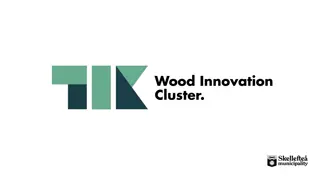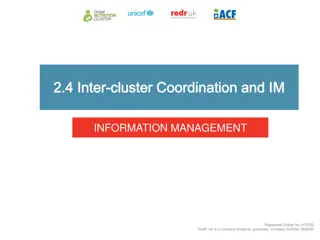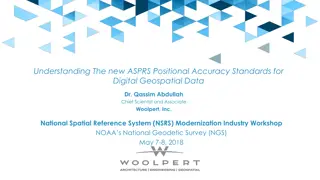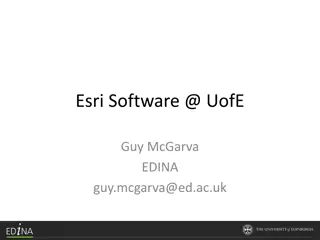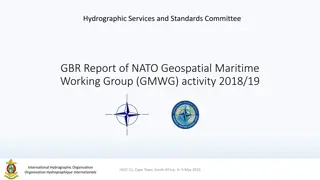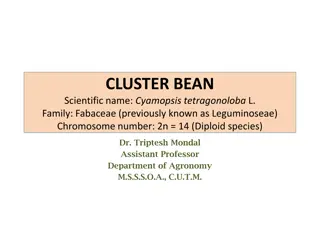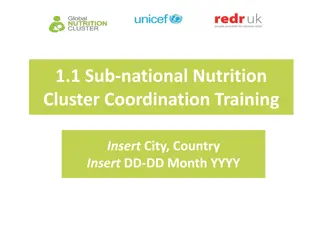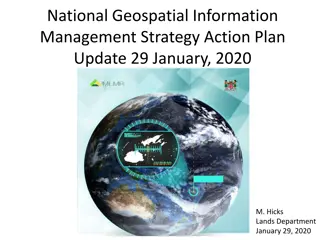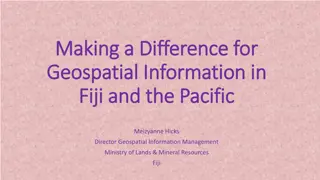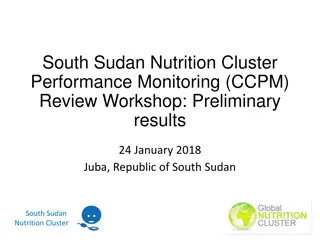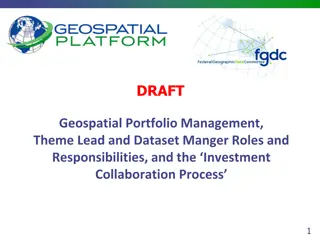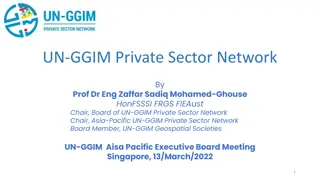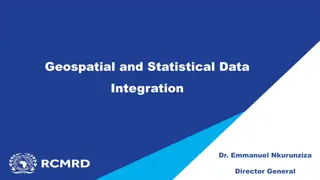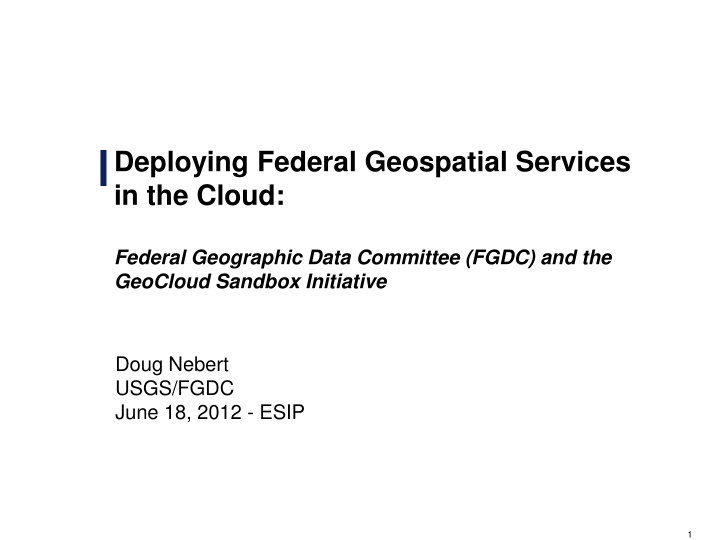
Deploying Federal Geospatial Services in the Cloud: GeoCloud Initiative Overview
Learn about the Federal Geographic Data Committee (FGDC) and the GeoCloud Sandbox Initiative, which aims to deploy geospatial services in the cloud. The initiative focuses on incubating and monitoring cloud data and service solutions to support the geospatial domain. Activities include acquiring, documenting, and deploying reference platform clouds, identifying solution architectures for geospatial data, monitoring costs, and certifying solution packages. Discover how the initiative aims to drive adoption of geospatial cloud infrastructure and share best practices with federal agencies.
Uploaded on | 2 Views
Download Presentation

Please find below an Image/Link to download the presentation.
The content on the website is provided AS IS for your information and personal use only. It may not be sold, licensed, or shared on other websites without obtaining consent from the author. If you encounter any issues during the download, it is possible that the publisher has removed the file from their server.
You are allowed to download the files provided on this website for personal or commercial use, subject to the condition that they are used lawfully. All files are the property of their respective owners.
The content on the website is provided AS IS for your information and personal use only. It may not be sold, licensed, or shared on other websites without obtaining consent from the author.
E N D
Presentation Transcript
Deploying Federal Geospatial Services in the Cloud: Federal Geographic Data Committee (FGDC) and the GeoCloud Sandbox Initiative Doug Nebert USGS/FGDC June 18, 2012 - ESIP Draft For Official Use Only 1
Background on GeoCloud Sandbox Initiative Initiated as an Architecture and Technology Working Group activity in December 2009 with a call to federal agencies to nominate geospatial applications for testing in the Cloud environment for a one-year prototyping process coordinated by FGDC and GSA Eleven projects have been nominated by federal agencies as existing projects with existing software suites to be deployed in commercial- or government-hosted Cloud environments Two deployment environments (platforms) were abstracted from the nominated projects: Open source service stack on Linux64 and a Commercial service stack on Windows 2008 Server 2
Deploying Federal Geospatial Services in the Cloud GeoCloud Goals and Activities Year-long project cycles to incubate and monitor externally-hosted Cloud data and service solutions for the geospatial domain, to support the Geospatial Platform activity Activities, Outcomes Acquire, compose, document, and deploy reference platform cloud that support Geospatial Platform standards Architectures Identify requirements-driven solution architectures and platforms for various sized deployments of geospatial data and services Cost Models Monitor costs, loads, issues and options in support of OMB IT project document guidance Document and assess cost models to support scalability, reliability, and redundancy Certification Certify Geospatial Solution Packages to facilitate re-use Expedite FISMA (security) certification and accreditation for agency adoption of packaged solution architectures Comparisons Document Best Practices and guides to agencies on adoption of geospatial Cloud infrastructure Support and collect cost comparison information from agencies for existing and externally-hosted Cloud solutions Document lessons learned and best practices 3
Platform as a Service (PaaS) A cloud platform (PaaS) delivers a computing platform and/or solution stack as a service, generally consuming cloud infrastructure and supporting cloud applications. It facilitates deployment of applications without the cost and complexity of buying and managing the underlying hardware and software layers. * (PaaS) The GeoCloud is piloting the deployment of candidate services via geospatial solution architectures (suites of software) by composing reference platforms on top of secure IaaS to provide common geospatial capabilities. (IaaS) * http://en.wikipedia.org/wiki/Cloud_computing 4
Platform as a Service Geospatial Platform agency data services for OMB Circular A-16 (Nationally Significant Data Sets) are predicated on high-availability Web services providing query-level access into terabyte to petabyte geospatial databases Platform (PaaS) complements other types of data hosting in the Cloud environment by providing Web services for standardized data access and processing Part of the Geospatial Platform that will facilitate geospatial data lifecycle management and agile publishing 5
Platform as a Service Architectural Framework Distinguishing Application, Platform and Infrastructure Application Servers: Provide the deployment environment for actual business applications with access to enablers, frameworks and runtimes, including interfaces and payload standards endorsed by the FGDC. Applications 10 identified GeoSpatial Applications + more agency apps Platform as a Service (PaaS) Platform Enablers: Platform enablers provide core supporting capabilities for developing , testing and deploying code, including DBMS, Directory, Queue, Service Bus, etc. A relational database is the most common enabler example but is not present in all platforms Platform Application Servers Platform Enablers (DB s, etc) Frameworks provide bundled access to common behaviors and services, which applications can rely upon. App Frameworks / Libraries Runtime Systems Libraries are reusable code modules which can be called directly from an application. Frameworks and Libraries save time and expense freeing developers from having to build common code and behaviors. Infrastructure (IaaS) Operating System Runtimes: provide the execution support for developing and running the code. Examples include Java, Python, Microsoft Common Language Runtime, etc. Virtual Machines / CPU Storage 7
GeoCloud Sandbox The Basics The sandbox is a shared Amazon AWS account with access to: Common platform images and artifacts A common provisioning mechanism for launching applications on platforms Projects load data and customize interfaces on existing Geospatial Cloud Platforms. There is a preference for Cloud-enabling pre-existing Web solutions. Platform images are periodically updated and enhanced by the community After a platform update, projects re-test their provisioning in sandbox Once tested, projects re-launch on the new platform After sandbox, projects operate in a project-specific account At the end of the year, projects take over the funding of their account using Departmental or government-wide Cloud acquisition mechanisms 8
Overview GeoCloud Platform Description Single centrally maintained platform on Amazon AWS Infrastructure OpenSource (OSS) based on CentOS, in full operation, Secure AMI from Census. In 2012, adding OSGeo Geospatial application server suite. ArcGIS based on Windows 2008 R2 with local security policies, in process (Versions 10.0 and 10.1) Born anew with every launch Provisioning mechanism Each platform launch has a persistent (EBS) volume that is specific to each project, not the platform The persistent volume must contain all data and customizations, including Esri software license (from each project) The persistent volume survives platform (software) changes 9
GeoCloud-II Instance Architecture Geospatial App Server Persistent Volume ArcGIS Server, SQLServer, Script envt. Win 2008 R2. Data Storage (Virtual Hard Disk) Mounted Project-specific Data, configuration files, Elastic Block Store (EBS), could host files behind DB mounts GIS Server, Web Services, Software, 64-bit Operating System, on EC2 OR OpenGeo Server, PostgreSQL, Script envt. CentOS 5.X Other Amazon Machine Image of other apps (Oracle, GeoNode, etc.)_ or clone of secure system from agency accesses System Image, incl OS (Optional) Each of these boxes represents a Virtual Machine A typical project will use two instances one for software (non-persistent), one for data 10
GeoCloud-II Kick-Off Selected ten+ projects that will be deploying either ArcGIS Server or OpenGeo Suite using secure Amazon Web Services in partnership with HHS and eGlobalTech Focus this year is on deployment of common software platforms for shared security certification and Web Services for geospatial data to be registered with the Geospatial Platform 11
GeoCloud Projects, 2012 Inland Electronic Navigation Chart (IENC) data set (USACE) Web-Based Vector Feature Editing of the NHD (USGS) Wildlife Data and Mapping, Joint Services (FWS/USGS) School District Demographic Data System (Dept of Education) Civil Applications Center Global Fiducials (USGS) Administrative Forest Boundary Data (USDA USFS) GeoMine Project (OSM) Farm Service Agency Imagery - NAIP (USDA FSA) GeoNode (NOAA) TIGERWeb (Census) General Land Office Proposal (BLM) StreamStats (USGS) Arctic SDI (USGS) 12




